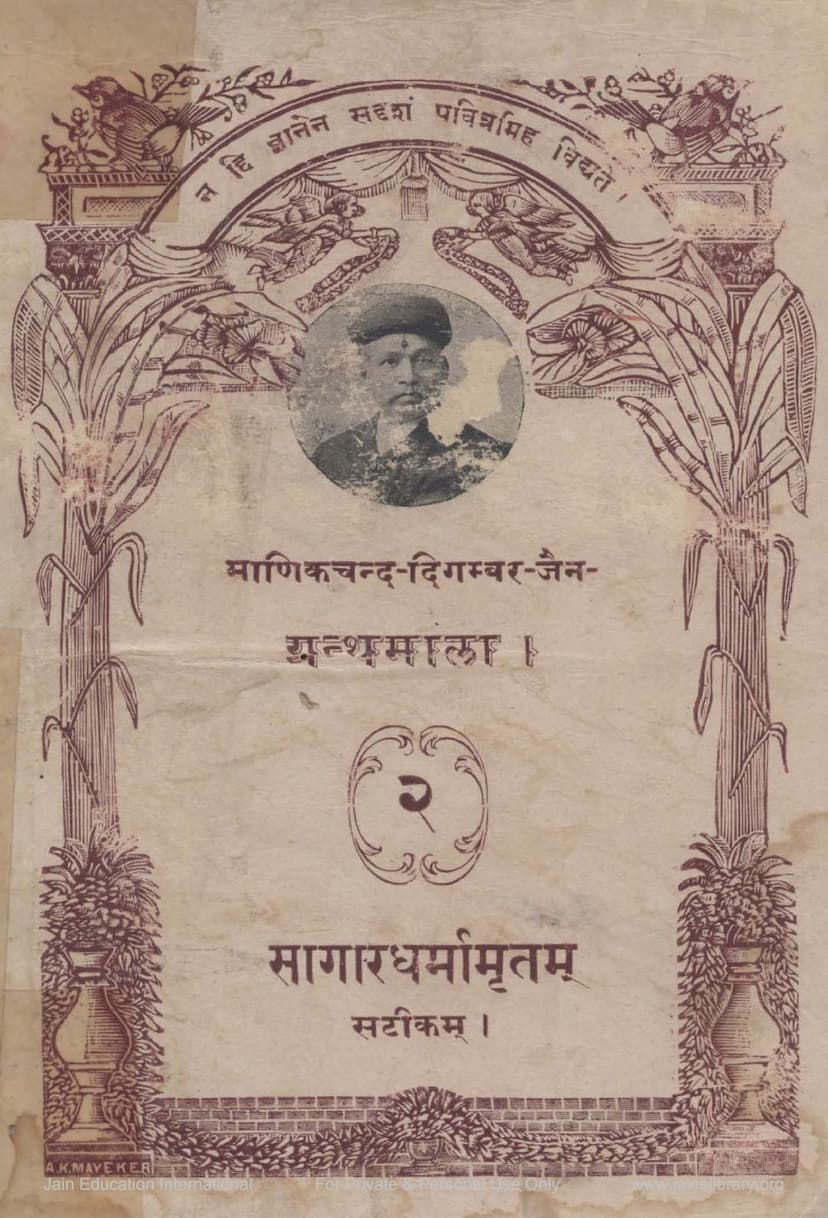Sagar Dharmamrutam
Added to library: September 2, 2025

Summary
Here's a comprehensive summary of the Jain text "Sāgāra Dharmāmṛtam" based on the provided pages:
Title: Sāgara Dharmāmṛtam (Ocean of Sustenance Dharma) Author: Āśādhara (with commentary by Bhavakumudacandrikā) Publisher: Māṇikacanda Digambara Jain Granthamālā Samiti Catalog Link: https://jainqq.org/explore/003099/1
Overview:
"Sāgara Dharmāmṛtam" is a significant Jain text, part of the "Digambara Jain Granthamālā" series, published in memory of Seth Māṇikacanda Hīrācaṅdajī. It is a commentary on the Sāgara (householder's) aspect of Jain Dharma, authored by the renowned Jain scholar Āśādhara. The text is presented with its commentary, "Bhavakumudacandrikā," and was revised by Pandit Manohara Lāla Śāstri.
Key Themes and Content:
The provided pages offer a glimpse into the introductory sections of this extensive work, focusing on:
-
The Purpose of the Granthamālā (Book Series): The series was established to commemorate the late Seth Māṇikacanda Hīrācaṅdajī, a philanthropic figure whose passion was the publication and propagation of ancient Sanskrit and Prakrit Jain texts. The series aims to revive and disseminate rare and valuable Jain literature, making it accessible to a wider audience and contributing to the recognition of Jain literature in world literature.
-
The Author, Āśādhara: The text provides a biographical sketch of Āśādhara, highlighting his lineage, birth, education (including studies in Jain grammar and logic under Mahāvīrācārya, a disciple of Vādirāja), and his prolific writing career. He is described as a scholar of exceptional erudition, proficient in various fields like grammar, poetry, lexicography, logic, medicine, and religious scriptures. He mentored numerous students, contributing significantly to the spread of Jain knowledge. His life journey involved moving from Māṇḍalagarh to Dhārāpurī, and later to Nalaka.
-
The Nature of a Sāgara (Householder): The initial chapters (specifically the beginning of Chapter 1 and 2 as seen in the text) define and describe the characteristics of a householder (Sāgara) in Jainism. They are depicted as individuals entangled in worldly life, often consumed by desires and passions, and turning away from self-knowledge. The text contrasts this with the ideal, emphasizing their potential for spiritual progress through adherence to Jain principles.
-
The Importance of Right Faith (Samyaktva): The text elaborates on the detrimental effects of wrong faith (Mithyātvam) in various forms – as overwhelming darkness, a grasping entity, or a painful thorn. It then explains the conditions necessary for acquiring right faith (Samyaktva), emphasizing the rarity of genuine spiritual guides (Sudeṣṭāraḥ) in the current era (Kali Yuga).
-
The Twelve Vows of a Householder: The text details the vows undertaken by Jain householders. It begins by defining the foundational vows (Aṇu-vrata) and then moves towards the vows that refine and elevate the practice of householder dharma. The initial chapters lay the groundwork by discussing the qualities of a virtuous householder (Bhadra) and the importance of right conduct, wealth acquisition, and devotion.
-
Ethical Conduct and Daily Life: The text outlines various aspects of a householder's daily life, including:
- Righteous Means of Livelihood: Emphasizing the importance of earning wealth through just means (Nyāyopātta-dhana).
- Devotion and Worship: Describing the practices of worshipping the Jinas (Jina-pūjā) through various rituals, including the significance of different festivals and offerings.
- Social Responsibility: Highlighting the duty to serve elders, guests, and the needy.
- Controlled Habits: Stressing the importance of regulated diet, speech, and activities.
- Prohibition of Harmful Practices: Explicitly condemning practices like gambling, consumption of meat, alcohol, and certain types of honey and fruits, as well as activities involving the harm of living beings.
- Renunciation and Moderation: Discussing the gradual path of renunciation and the importance of moderation in worldly possessions and desires.
- The Path to Liberation: The ultimate goal of adhering to these principles is described as achieving spiritual liberation (Moksha).
-
The Stages of Householder Spiritual Practice: The text outlines different levels of householder practice, from the initial stages (Pākṣika) to more advanced ones (Naiṣṭhika and Sādhaka), culminating in a state of detachment and spiritual progress.
-
The Nature of Sins and Purification: The text delves into the nuances of various sins and the methods of purification (Prāyaścitta) through penance and ethical conduct.
-
The Importance of the Spiritual Guide (Guru): The text emphasizes the indispensable role of a spiritual teacher in guiding individuals toward correct understanding and practice.
Overall Significance:
"Sāgara Dharmāmṛtam" serves as a comprehensive guide for Jain householders, providing detailed instructions on ethical conduct, religious observances, and the spiritual path towards liberation. It underscores the practical application of Jain philosophy in daily life, emphasizing that even within the worldly context, spiritual progress is attainable through diligent adherence to prescribed duties and vows. The text reflects the depth of Jain thought and the meticulousness with which scholars like Āśādhara articulated these principles. The publication of this work through the Māṇikacanda Digambara Jain Granthamālā is a testament to the community's commitment to preserving and promoting its rich literary heritage.